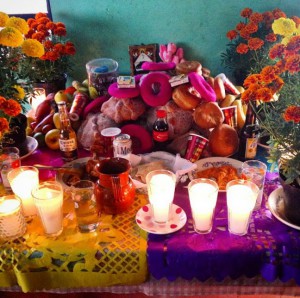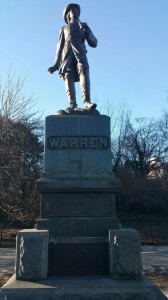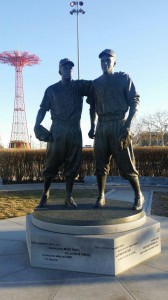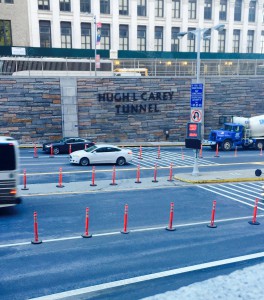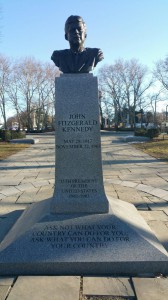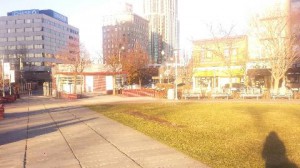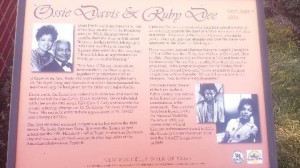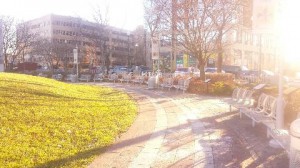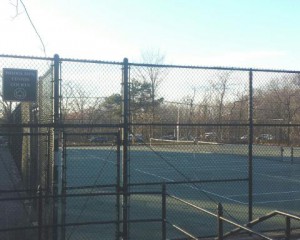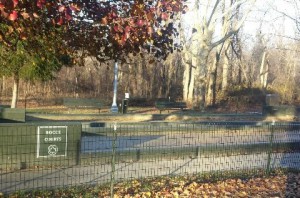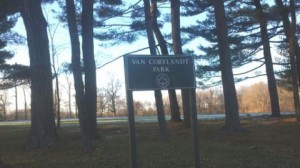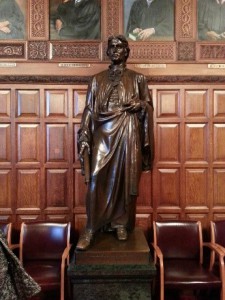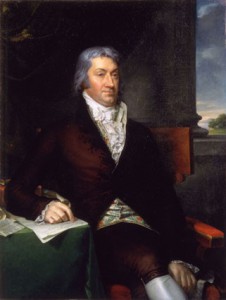Photo was taken in Brooklyn, East New York. The person being commemorated in this photo is Zsatavia F. Haynes. She was also know to everyone that knew her as princess Tay-Tay. Born in Brookdale Hospital located in Brooklyn, East New York at one pound and a few inches. She’s being honored due to her life ending at the age of nineteen, on February 13, 2011. Doctor’s said she would not live pass her tenth birthday because she had cerebral palsy, which left her unable to walk, talk, or feed herself. Even with all her disadvantages she still was able to speak without words with her bright smile, she would scream with excitement whenever some one she adore walked into a room, and she would cry whenever she was disappointed. She could not speak, but left a big void in everyone heart with her departure. 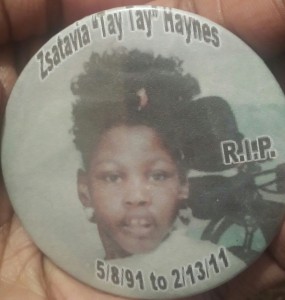
Union Army General Gouvernor Kemble Warren
This picture was taken from the oval plaza and entryway to Prospect Plaza at the Grand Army Plaza in Brooklyn, NY. It is of Union Army general Gouverneur Kemble Warren (1830-1882). He was honored for his bravery before and during the Civil War.
This was well deserved and shows great dedication towards one’s country.
http://www.nycgovparks.org/parks/grand-army-plaza/monuments/1648
This sculpture by Henry Baerer (1837–1908) honors the distinguished Union Army general Gouverneur Kemble Warren (1830–1882). It is one of three Civil War monuments that grace this oval plaza and entryway to Prospect Park, which was first laid out in the 1860s and dedicated in 1926 to the Grand Army of the Republic (the Union Army in the Civil War).
General Warren was born in Cold Spring, in Putnam County, New York. He graduated from the United States Military Academy at West Point in 1850. Before the Civil War, he helped the Army Corps of Engineers survey areas west of Mississippi, oversaw rapids and canal improvements, and taught mathematics at West Point.
Warren was named Lieutenant Colonel of the Fifth Regiment in New York in 1861, and fought at Big Bethel, Virginia. Later, as Captain, he led the Yorktown siege of 1862, and was engaged in combat at Malvern Hill, Harrison’s Landing, Second Bull Run, Antietam, Centreville, and Fredericksburg. He was appointed Brigadier General in September 1862, and named Chief Topographical Engineer of the Army of the Potomac in 1863. At the famous battle of Gettysburg in 1863, he was wounded at Little Round Top, and a monument was later placed there to commemorate his valor.
Warren subsequently served as the chief engineer and the commanding officer at numerous battle sites, though his actions were questioned at Five Forks in Virginia. One account said Warren “made victory decisive there,” but General Philip Sheridan, feeling that Warren was negligent in his duties, relieved him of his station. Though a court of inquiry exonerated Warren of Sheridan’s charges 14 years after the war, Warren was said have been broken personally and ruined professionally. Warren remained in the armed services as a Lieutenant Colonel of Engineers until he died in Newport, Rhode Island on August 8, 1882.
Sculptor Henry Baerer was born in Kirscheim, Germany, and came to the United States in 1854. He was especially well-known as a portrait sculptor, and contributed six sculptures to the parks of New York City, including statues of composer Ludwig van Beethoven in Prospect and Central Parks, and a bust of industrialist Conrad Poppenhusen (1818-1883) in College Point, Queens.
In 1938, the city monuments crew cleaned and repatined the sculpture and bronze tablet set within its base. Having since suffered more than 60 years of exposure to the elements, the sculpture was conserved in 2001.
The American soldier Gouverneur Kemble Warren was born at Coldspring, New York, on the 8th of January 1830, and entered West Point in 1846, graduating in 1850. He was assigned to the engineers, and for several years was employed in survey work in the West, where he took part in some expeditions against the Indians. In 1859 he was made assistant instructor in mathematics at West Point. But two years later, at the outbreak of the Civil War, the scientific subaltern was made lieutenant-colonel of volunteers and posted to the newly raised 5th New York Volunteer Infantry. He was fully equal to the task, for his regiment was very soon brought into a state of marked efficiency. In August he was promoted colonel. He commanded a brigade of the V. corps at Gaines’s Mill, Second Bull Run and Antietam, and was shortly afterwards promoted brigadier-general of Volunteers. During the Fredericksburg campaign he was on the engineer staff of the Army of the Potomac, but after Chancellorsville he was appointed chief of engineers in that army, and in that capacity rendered brilliant services at Gettysburg, his reward being promotion to major-general U.S.V. and the brevet of colonel in the regular army. When the Army of the Potomac was reorganized in the spring of 1864 Warren returned to the V. corps as its commander.
His services in the Wilderness and Petersburg campaigns proved his fitness for this large and responsible command, but his naturally lively imagination and the engineer’s inbred habit of caution combined to make him a brilliant but somewhat unsafe subordinate. He would have become one of the great chiefs of staff of history, or even a successful army commander, but he sometimes failed where a less highly gifted man would have succeeded. He was at his best when the military situation depended on his exercising his initiative, as on the first day in the Wilderness, in which his action saved the army, at his worst when, as on the 10th of May before Spottsylvania, he was ordered to attempt the impossible. On the latter occasion bothUlysses S. Grant and George Gordon Meade threatened to relieve him of his command, and Humphreys, the chief of staff of the army, was actually sent to control the movements of the V. corps.
http://www.nndb.com/people/516/000050366/
Jackie Robinson and Pee Wee Reese of the Brooklyn Dodgers
When Hollywood tells you a movie is “based on a true story,” that means you’re about to eat popcorn while watching lies. The Jackie Robinson movie,”42,” begins with those words on the screen. OK, I buy in. I know nuance runs second to amped-up drama in big-budget movies. Still, let’s talk about one scene.
During a game in Cincinnati, when Robinson is the target of racist harangues from the box seats, Pee Wee Reese walks across the infield grass. He walks slowly. The music suggests suspense. Reese walks from shortstop to first base. There he hangs an arm over Robinson’s shoulders. They chat, the white man from Kentucky and the black man born in Georgia. Reese is smiling, laughing. Robinson’s face shows confusion slowly reshaping itself into contentment. The music rises to let us know This Is The Drama, Folks.
What a moment.
Long before the movie, people raised money to immortalize the moment in bronze. At Brooklyn’s minor league ballpark, a heroic statue shows Reese with his arm over Robinson’s shoulders.
The moment was brave, caring, even sweet.
Except, most likely, it never happened.
Whatever happened, maybe it happened in Cincinnati, maybe in Boston. It could have happened anywhere in the late 1940s when Jim Crow laws and customs divided Americans. In “42,” it happens at Cincinnati’s Crosley Field in 1947. Reese, portrayed as a Southern innocent, if not a yokel, complains to the Dodgers’ boss, Branch Rickey, about a letter threatening him if he plays alongside Robinson. Rickey trumps that single letter with hundreds addressed to Robinson. Thus instructed, Reese realizes the burden that Robinson has carried alone through that season. So, hearing the Crosley Field racists, Reese crosses the infield to Robinson. The crowd is rendered silent.
It happened in Atlanta in 1947. A letter had come to Robinson with a promise that the Ku Klux Klan would kill him if he showed up in that city’s Ponce de Leon Park. That night, as the Dodgers warmed up, Robinson and Reese threw alongside each other. Reese looked at Robinson and said, “Damn, Jackie, get the hell away from me, will you? The guy might be a bad shot.”
They laughed and went on warming up.
That would make a nice statue, too.
This picture was taken at the Brooklyn ball field, KeySpan Park in Coney Island of Jackie Robinson and Pee Wee Reese of the Brooklyn Dodgers, who were honored for breaking the long-held racial barrier in the major leagues during the 1940’s. I think this is a very powerful and strong message, and also serves as a reminder of how far we have come.
http://www.nytimes.com/2005/11/02/sports/baseball/02robinson.html?_r=0
Hugh L. Carey
This picture was taken near the Battery Tunnel which is now called “Hugh L. Carey Tunnel” It was very challenging to get this shot of this picture that I risk placing my iphone on the edge of the bridge I was standing on just so I could have zoomed in. It was a very tedious momemt for me, but it felt really accomplishing after I was done.
Hugh L. Carey, the governor who helped rescue New York from the brink of financial collapse in the 1970s and tamed a culture of ever-growing spending, died Sunday at his summer home on Shelter Island, N.Y. He was 92.
His death was announced by the office of Gov. Andrew M. Cuomo. “Governor Carey led our state during a time of great financial turmoil and pulled us back from the brink of bankruptcy and economic ruin,” Mr. Cuomo said in the statement.
From 1975 through 1982, as the state’s 51st governor, Mr. Carey led a small group of public servants who vanquished the fiscal crisis that threatened New York City and State — the direst emergency a governor had faced since the Depression — by taking on powers over the city’s finances that no governor had wielded before and none has wielded since.
Hugh Carey rose to power as a Democrat outside his party’s machine. He began the 1974 campaign for governor as a recently widowed congressman from Brooklyn, a long shot who was not taken seriously, yet he cruised to one of the most resounding victories in the state’s history.
But he spent his final years as governor frustrated. Absent an emergency, he often seemed bored with the job.
The political strategist David Garth, who was one of Mr. Carey’s closest associates, once said of him: “Hugh Carey on the petty issues can be very petty. On the big stuff, he is terrific.”
Running as a Democrat, Carey was elected to the United States House of Representatives in 1960, unseating Republican incumbent Francis E. Dorn. He served seven terms. He served on the House Ways and Means Committee and led the effort to pass the first Federal Aid to Education program. He was elected Governor of New York in 1974 and resigned his Congressional seat on December 31, 1974. Carey was reelected in 1978, serving two full terms as Governor. On January 1, 1983 he was succeeded by his lieutenant governor, Mario Cuomo. Carey then returned to private law practice with the firm of Harris Beach in New York City, where he resided until his death in August 2011. He was the first congressman from Brooklyn to oppose the Vietnam War.
Carey became the state’s first Democratic Governor in 16 years when he was elected governor in 1974, unseating incumbent RepublicanMalcolm Wilson, who had assumed the office after Nelson Rockefeller resigned in December 1973 (to work on the Commission on Critical Choices for Americans). Nationally, the 1974 election were dominated by the Watergate scandal which had destroyed President Richard Nixon‘s presidency and impacted negatively Republicans in general, making them nationally unpopular. In 1974, Democrats also recaptured the New York State Assembly.
Carey is best remembered for his successful handling of New York City’s economic crisis in the late 1970s. As Governor he was responsible for building the Jacob K. Javits Convention Center; Battery Park City; the South Street Seaport and the economic development of the NYC boroughs outside Manhattan. He also helped provide state funding for the construction of the Carrier Dome at Syracuse University. He is also remembered for preventing conservative legislators from reinstating the death penalty and preventing such legislators from taking away state abortion laws.
In 1947, Carey married Helen Owen. They became the parents of Alexandria, Christopher, Susan, Peter, Hugh, Jr., Michael, Donald, Marianne, Nancy, Helen, Bryan, Paul, Kevin, and Thomas. His wife, Helen, died of breast cancer in 1974. Peter and Hugh, Jr. died in an automobile accident in 1969. Paul, who served as White House Special Assistant to President Bill Clinton as well as 77th Commissioner of the Securities and Exchange Commission, died of cancer in 2001.
In 1981, Carey married Evangeline Gouletas, a Chicago-based Greek-American real estate mogul.[6] This marriage proved controversial and a political liability. The marriage generated controversy, since Gouletas had affirmed on the marriage license that she had two ex-husbands, when she actually had three. Gouletas also said that her first husband, with whom she had a daughter, was dead, but he was still alive at the time. The marriage also caused trouble for Carey with the Catholic Church, since he married a thrice-divorced woman in a Greek Orthodox Church. Carey and Gouletas-Carey divorced in 1989.[7] Carey later described this marriage as “his greatest failure.”[8]
Carey died surrounded by his family on August 7, 2011. He was at his summer home on Shelter Island, New York.[9]
http://en.wikipedia.org/wiki/Hugh_Carey
John F. Kennedy
This picture was taken at the Brooklyn’s Museum Grand Army Plaza. It is of the 35th President of the United States who served as naval officer during world war II and was also a Congressman from Massachusetts and a States Senator. He is being honored for the launched initiatives such as Peace Corps and with Great Britain and the Soviet Union signed the nuclear test-ban treaty of 1963. He also weathered the disastrous Bay of Pigs Invasion of Cuba (1961) and Cuban Missile Crisis of 1962. He was assassinated in Dallas on November 22, 1963, and was famous for his line “Ask not what your country can do for you; ask what you can do for your country.”
I like that he was recognized for such greatness. I also like his famous quote “Ask not what your country can do for you; ask what you can do for your country.”
This monument honors John Fitzgerald Kennedy (1917-1963), the thirty-fifth President of the United States.
After serving as a naval officer during World War II, Kennedy was a United States Congressman from Massachusetts from 1947 to 1953, and a United States Senator from 1953 to 1960. Narrowly defeating Richard M. Nixon in the tightly contested election of 1960, he was elected the nation’s first Catholic president. As president he launched initiatives such as the Peace Corps, and with Great Britain and the Soviet Union signed the nuclear test-ban treaty of 1963. He also weathered the disastrous Bay of Pigs Invasion of Cuba (1961) and Cuban Missile Crisis of 1962.
On November 22, 1963 he was assassinated in Dallas, Texas by Lee Harvey Oswald. Shortly after the assassination on November 22, 1963 of President John Fitzgerald Kennedy, Brooklyn Borough President Abe Stark proposed to Mayor Robert F. Wagner and Parks Commissioner Newbold Morris that a monument be erected in Kennedy’s honor. The American Institute of Architects sponsored the monument competition, and Morris Ketchum, Jr. and Associates were selected to design the monument.
The promontory where the monument is situated in Grand Army Plaza, was selected for its physical prominence, historic significance, and scenic beauty. The monument’s design went through an evolution, and one time included an eternal flame. Eventually the design was reduced to a more modest oblong pedestal sheathed in Vermont marble, from which projects a bronze portrait bust of Kennedy, crafted by noted Brooklyn-based sculptor Neil Estern (born 1926). Estern, then at the outset of his career, later served as president of the National Sculpture Society, also created the statue of Mayor La Guardia in Manhattan and a sculpture of Franklin Delano Roosevelt, Eleanor Roosevelt, and their dog Fala, at the FDR Memorial in Washington, D. C.
On August 24, 2010 the redesigned monument was rededicated. At that time Kennedy’s former speechwriter Ted Sorenson–often credited with the president’s most soaring rhetoric–commented: “It is fitting that the President, elected 50 years ago this year, who demonstrated more than any other since FDR his concern for the arts, John F. Kennedy, should be the subject of a superb work of sculpture in the heart of New York City, where his victory on November 8, 1960 clinched his election and his subsequent years in the White House devoted to the arts, social justice and world peace.”
President Kennedy’s daughter Caroline wrote: “I hope everyone who passes this memorial will reflect on his words ‘Ask not what your country can do for you; ask what you can do for your country,’ and consider how we can all contribute our talent and energy to the betterment of the nation.”
http://www.nycgovparks.org/parks/grand-army-plaza/monuments/854
R.I.P Ms Ruby Dee
Library Green Lawton Street, New Rochelle, NY 10801
The oscar-nominated actress, poet, playwright, and civil rights activist, Ruby Dee died June 11, 2014 at her home in New Rochelle. Her Broadway career started in 1943 where she also met her true love and life partner, Ossie David in a 1946 Broadway play.
 “The New Rochelle Public Library Theatre and Library Green were named for Ossie Davis in 2005 and the renaming of Library Green for Ruby Dee is anticipated for spring 2015.” (http://patch.com/new-york/newrochelle/ruby-dee-park-library-green-dedicated-new-rochelle)
“The New Rochelle Public Library Theatre and Library Green were named for Ossie Davis in 2005 and the renaming of Library Green for Ruby Dee is anticipated for spring 2015.” (http://patch.com/new-york/newrochelle/ruby-dee-park-library-green-dedicated-new-rochelle)
These two began their journey and making their mark by appearing in many films and plays until Davis death in 2005. They were known as the “power couple” of their time, both committed to social justice as to the performing arts community. Among Davis and Dee’s most-notable joint stage appearances were those in A Raisin in the Sun (1959) and Spike Lee‘s Do the Right Thing (1989) and Jungle Fever (1991).
However, Dee was widely known for her own accomplishments and appeared in numerous projects without Davis. In fact, Dee has contributed over 70 films for which she is famously known. One of her best known films was A Raisin in the Sun reconducted in 1961. She became the first African American woman to play leading roles at the American Shakespeare Festival, in 1965 to as well starring in leading roles on soap operas in the 1960’s. She also went on to winning an Emmy for her 1990’s performance in “Decoration Day.” She received her first Academy Award nomination for best supporting actress in 2008 for her work in “American Gangster.” Dee was obviously a phenomenal women of her 70 plus year career; she received numerous awards for her stage and screen performances and became a voice to many young women.
So to honor her legacy Library Green will now be known as “The Ruby Dee Park at Library Green”
I have always loved everything about this wonderful lady. Meeting her would have meant the world to me. Although, I am struck by her lost, I’m glad to come to such a beautiful park to commemorate her legacy. I’m just so happy to see people come out, celebrate, and keep her legacy at the forefront of the community. just to image that this park is right across the library that I’m a member (although I live in the Bronx/ better books here). And, this is a place people can enjoy the beauty of history by a simple walk in the park enliven by the hall of fame. This one of New Rochelle’s great public spaces.
It was the New Rochelle Mayor Noam Bramson and a commemoration committee idea to rename the park in Ruby Dee’s name. Mayor Bramson stated, “Library Green park represents so much of what Ruby Dee held dear- beautiful gardens, a space welcoming of all ages and ethnicities, and a platform for arts and culture- not to mention our historic Walk of Fame. It is a fitting location for a tribute.”
She didn’t only play outspoken movie roles that touched many of our hearts, but she also acted out on social justice issues in America, fighting for many African American rights as citizen. We have Ruby Dee to thank for being one of the advocates who’ve broken through the racial barriers on Broadway, and Television.
“We are artists also, and workers above all. We are image-makers. Why can’t we image-makers become peacemakers too? – Ruby Dee
Remembering the Revolutionary War
Van Cortlandt Park East, Bronx, NY 10470 Indian Field
“This tract of land honors Chief Abraham Ninham and the 17 Mohican Indians who died here during a mission to aid the Americans in the Revolutionary War.”
Van Cortlandt Park is one of my favorite places to run in New York. I love jogging through this exquisitely beautiful woodlands each morning. It’s New York City’s fourth largest park and has the largest freshwater lake in the Bronx. I’m definitely more of a lake gal; the lake plays a major role in my life. However, after going here for so long, it didn’t occur to me till now that this park is a historic landmark.
Before, I ever enjoyed the solitude and beauty of this private woodlood such as hiking, biking, fishing, wildlife viewing, and picnicking, Weckquaesgee Indians.lived in the Van Cortlandt Park area and hunted the forested upland, fished in its wooded swamps and enjoyed this serenity before anyone else. They were the first known original inhabitants.
After Van der Donck death, the land changed hands several times until 1694, when Jacobus Van Cortlandt (of what is now Van Cortlandt Park) purchased it. In 1888, the City of New York took title to Van Cortlandt Park.
At the outbreak of the revolutionary war in 1778, Chief Abraham Ninham and 17 Mohicans from Stockbridge, Massachusetts, were killed or captured for the defense of American liberty. This park serves as a reminder of the attack on Stockbridge Indians by the Hessian mercenaries (British forces). “The clash was the only revolutionary battle to occur entirely within the bounds of today’s Van Cortlandt Park.” (http://www.nycgovparks.org/parks/VanCortlandtPark/highlights/11610)
Van CortlantPark Lake (although not located on the Indian Field)
Our Father: Robert R. Livingston
Robert R. Livingston Born 1746 — Died at Albany, March 26, 1813
This statue is located in the courtroom of the New York Court of Appeals in Albany and placed there by the bar of the State.
In his right hand, he holds a scroll containing the procedure of the Court of Chancery which he remolded as the Court of Equity.
Robert R. Livingston was one of the Founding Fathers of the United States and the first chancellor/Judge of the State of New York in 1777, when the first New York Constitution was adopted.
“Chancellor n. from the old English legal system, a chancellor is a judge who sits in what is called a chancery (equity) court with the power to order something be done.” (http://legal-dictionary.thefreedictionary.com/Chancellor)
This was the highest judicial position in the state of these times. He was also known as one of the greatest lawyers of the revolutionary era. He helped formulate the Court of Appeals in New York when the old Court of Errors abolished in 1846.
His most important contribution during this period was when he administered the oath of office to President Washington April 30, 1789 and his involvement on the committee that drafted the Declaration of Independence with Benjamin Franklin, John Adams, and Thomas Jefferson. However, at the time of signing the Declaration of Independence, he was elsewhere working on New York City’s constitution and forming its committee.
Robert R. Livingston was one of the most prominent revolutionary leader and statesmen of his day. He led an honorable life. I respect his drive for independence for all our nation; He was the first confederation secretary for foreign affairs and played a major role regarding peace with Great Britain. He was a man of liberal principles of equal liberty. He has earned his position of honor.
Triborough Bridge now is Robert F. Kennedy Bridge
I took this picture because this bridge pictured here is of the formerly known as the Triborough Bridge on Astoria Blvd. The bridge was rightfully named so because it connects the boroughs of Queens, Manhattan and the Bronx. The bridge has been opened since 1936.
Mr. Robert F. Kennedy was the United States attorney general when his brother John F. Kennedy was president. 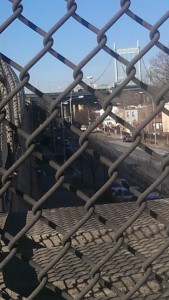
On November 19, 2008, the Triborough Bridge was officially renamed after Robert F. Kennedy at the request of the Kennedy family. Forty years had since passed when the New York United States Senator and former U.S. Attorney General had been assassinated during his campaign for president during the 1968 presidential bid.
I have lovefor the Kennedy’s I sympathize for the loss of lives in their family; I would not know how to deal with their family losses. This bridge is on Astoria Blvd and 29th street under the L of Astoria Blvd, N train station stop.
http://en.wikipedia.org/wiki/Robert_F._Kennedy
Dia de Los Muertos, my family style.
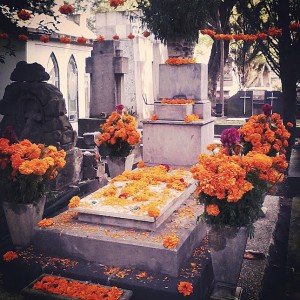 I am of Mexican culture which means we celebrate that which is called El dia de los muertos it is similar in its tradition with All Saints Day. It is a yearly tradition which is on November 1st and 2nd. My family tradition in Mexico is by decorating his tomb with a flower named “Flor de Muertos” which means Flowers of the Dead it has a distinct scent not sweet but rather tart, tangy. We believe that on this very day our dead loved ones are allowed to walk through the gates of this realm and enjoy the treats, food and beverage which they enjoyed when they walked among us.
I am of Mexican culture which means we celebrate that which is called El dia de los muertos it is similar in its tradition with All Saints Day. It is a yearly tradition which is on November 1st and 2nd. My family tradition in Mexico is by decorating his tomb with a flower named “Flor de Muertos” which means Flowers of the Dead it has a distinct scent not sweet but rather tart, tangy. We believe that on this very day our dead loved ones are allowed to walk through the gates of this realm and enjoy the treats, food and beverage which they enjoyed when they walked among us.
This picture was taken in Mexico, Dia de los Muertos 2014, my family was the first one at the cemetery this year.I personally love the tradition. It is nice to think we can walk the paths we once did and know that we no longer are a part of that realm but now of another. Also, we do not leave any photograph of our loved one for we fear that on their visiting night they will see their mortal body and never leave to our mortal thus forcing them to roam among us in pain, anger and resentment of their death.
Below is what we did at home for him being that we live an apartment and my living room is not too large. We also ran out of tequila so we opted for some rum I hope he doesn’t mind we did include his favorite fruit which was apple and Mexican bread and candies my grandfather had a sweet tooth.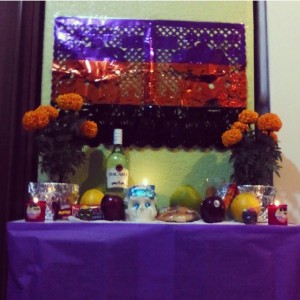
My family in Mexico however is able to do the real deal below is the picture I took last year, I really wish I was there. 